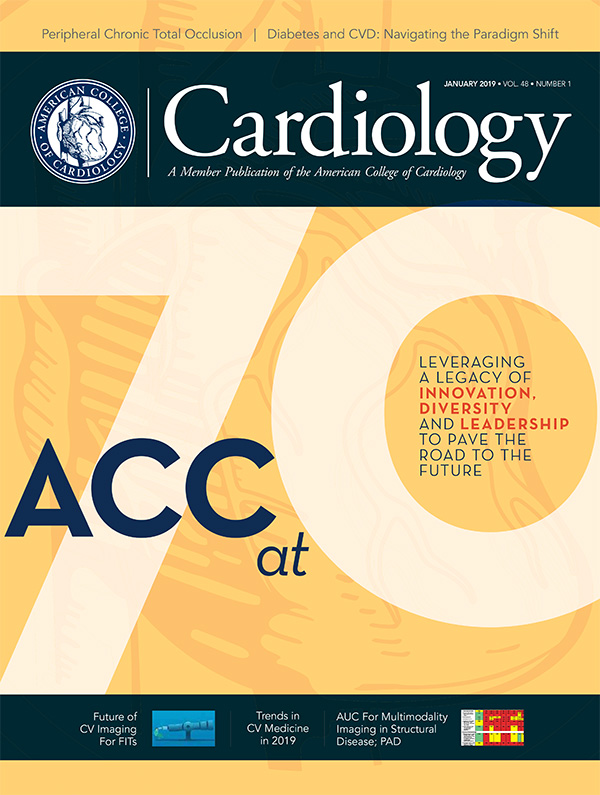JACC in a Flash
Featured topics and Editors' Picks from all of ACC's JACC Journals.
Alcohol Septal Ablation Safe, Effective For Hypertrophic Obstructive Cardiomyopathy
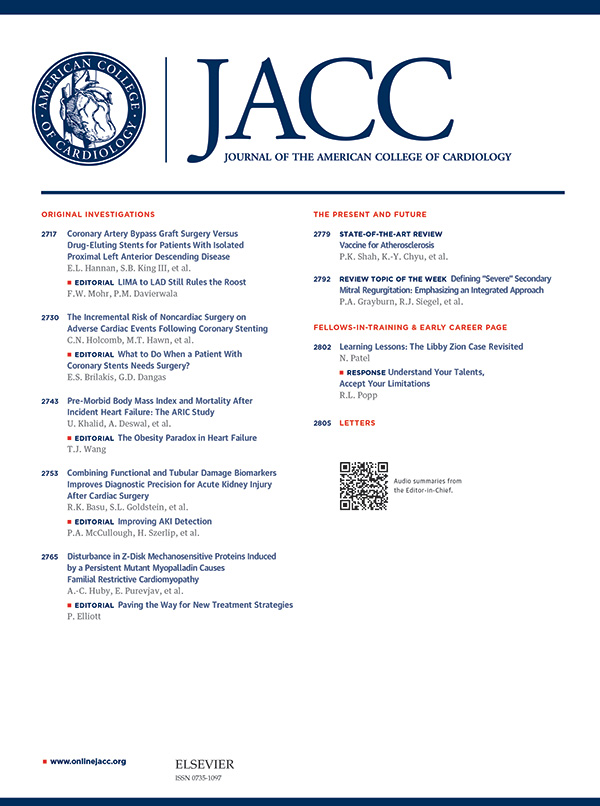
Percutaneous transluminal septal myocardial ablation (PTSMA) is safe, shows ongoing symptomatic improvement and has excellent long-term survival, making it a reasonable alternative to surgical myectomy in patients with hypertrophic obstructive cardiomyopathy (HOCM), according to a study published in the Journal of the American College of Cardiology.
Between May 2000 and June 2017, Angelika Batzner, MD, et al., performed PTSMA with alcohol injection in 952 patients (age 55.7±14.9 years; 59.2 percent men; 73.3 percent New York Heart Association functional class III or IV; 50.3 percent syncope; 10.3 percent sudden cardiac death in family). Up to five branches had to be tested by contrast echocardiography to identify the target septal branch without potential alcohol misplacement. The primarily chosen first septal branch could be confirmed as the target branch in 83 percent of patients.
All patients were followed for 6.0±5.0 years. Improved clinical symptoms were reported in 898 (94.3 percent) patients and 34 (3.6 percent) patients felt unchanged compared with the time before ablation. Re-ablation was necessary in 164 (18.1 percent) patients, with hemodynamically and clinically insufficient follow-up result after the first procedure. Surgical myectomy was necessary in 18 (1.9 percent) patients. Additionally, 49 (5.1 percent) received an ICD, while 50 (5.3 percent) patients developed permanent atrial fibrillation and 14 (1.5 percent) patients suffered from ischemic stroke.
A total of 70 patient died during follow-up. Kaplan-Meier survival analysis resulted in an estimated five-year survival of 95.8 percent, an estimated five-year survival free of cardiovascular events of 98.6 percent and an estimated five-year survival free of cardiac events of 98.9 percent. The authors stress that operator's expertise and availability is one of the most important criteria to achieve a good result in both PTSMA and myectomy.
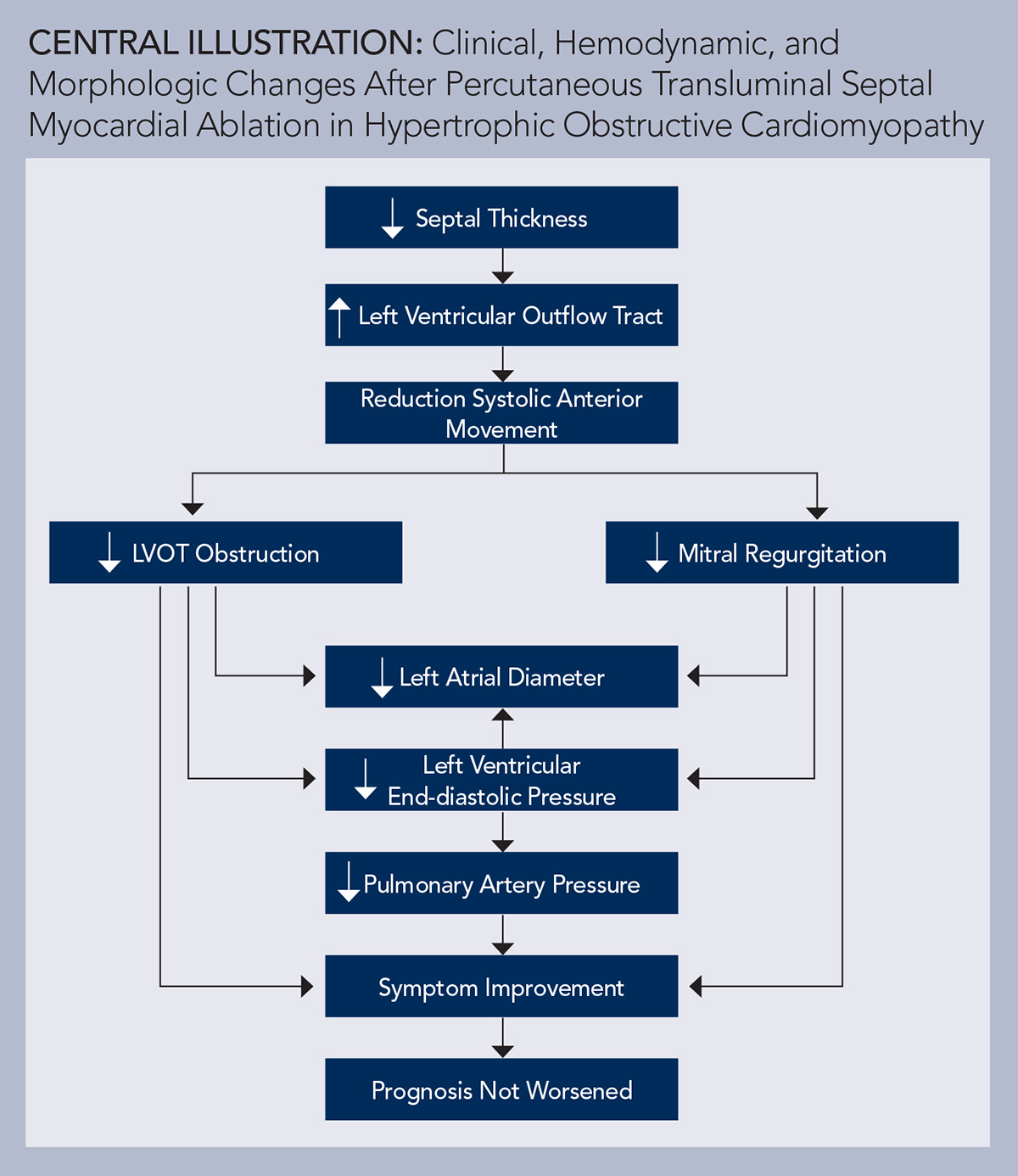
Batzner A, Pfeiffer B, Neugebauer A, et al. J Am Coll Cardiol 2018;72:3087-94.
New AUC For Peripheral Artery Intervention Released

New guidance for clinicians in determining the role of different revascularization options for patients with peripheral artery disease (PAD) was published in the Journal of the American College of Cardiology. The document, 2018 Appropriate Use Criteria for Peripheral Artery Intervention, was developed by the ACC, American Heart Association, Society for Cardiovascular Angiography and Interventions, Society of Interventional Radiology and Society for Vascular Medicine.
The writing group, led by Steven R. Bailey, MD, FACC, used published guidelines, trial data and expert opinion to identify 45 common clinical scenarios within the field of PAD. An independent rating panel then scored the scenarios to rank each as "appropriate," "may be appropriate," or "rarely appropriate." The indication topics include renal artery stenosis, lower extremity disease, critical limb ischemia, asymptomatic artery disease, options for endovascular treatment when deemed appropriate or may be appropriate, and secondary treatment options for lower-extremity disease.
Of note, the rating panel deemed patients with cardiac destabilization such as recurrent heart failure or uncontrolled unstable angina despite maximal medical therapy and severe renal artery stenosis as "may be appropriate" for renal stenting. For patients with PAD and intermittent claudication who have already completed a guideline-directed medical therapy and structured exercise strategy, surgical or endovascular randomization will depend on the risk-benefit ratio unique to each patient. In patients with critical limb ischemia, both endovascular and surgical revascularization "is critical for the reduction of high morbidity and mortality rates."
The document also points out several areas where research is lacking. In the asymptomatic artery disease category, the writing group explains that there is no published research, so the recommendations represent a consensus of expert opinions. In addition, "further comparative investigation is recommended into the risks and benefits of atherectomy in femoral popliteal lesions." Research is also limited in comparing treatment modalities for in-stent stenosis, venous graft failures and arterial graft failures.
The authors explain that although AUC are evidence-based, they are "not a replacement for clinical judgement and practice experience in determining the best options for individual patients." According to Bailey, "AUC are designed to provide an assessment of care decisions in aggregated patient populations, not to determine reimbursement or coverage decisions for the treatment of individual patients."
The authors conclude that moving forward, "future studies to evaluate implementation of these AUC in clinical settings will be useful." As the field of PAD is continuously evolving, they add that a regular review of these scenarios will be necessary. "We expect this AUC to undergo frequent review and updates as new evidence becomes available," Bailey adds.
Bailey SR, Beckman JA, Dao TD, et al. J Am Coll Cardiol 2018;Dec 17:[Epub ahead of print].
Review Examines Risk of Atherothrombotic Events in ACS Patients

Despite advances made in secondary prevention for acute coronary syndrome (ACS) over recent decades, these patients are still at high risk for recurrent atherothrombotic events, according to a review published in the Journal of the American College of Cardiology.
Guglielmo Gallone, MD, et al., write that the advent of PCI was expected to lead to improved outcomes in these patients, but that current evidence has not shown superiority of coronary revascularization (aside from culprit lesion intervention in ACS) over medical therapy. Despite current guideline-directed medical therapy (GDMT), a consistent proportion of post-ACS patients experience recurrent atherothrombosis, representing "residual risk." This recognition offers an opportunity to improve outcomes even beyond current GDMT in patients post-ACS. The authors examine clinical trials that have investigated more aggressive lipid-lowering and antithrombotic interventions, which show room for improvement in outcomes.
The authors share three important clinical implications of recent studies: 1) An "as low as achievable with maximally tolerated therapy LDL-C value" strategy may reduce events beyond approaches in current guidelines that recommend a "target LDL-C value" or "statin therapy intensity" approaches; 2) A nonstatin agent combined with the maximally tolerated statin dose irrespective of baseline LDL-C levels can further reduce recurrent events; and 3) These aggressive strategies may have particular importance in the secondary prevention setting in which the absolute risk decreases substantially for each LDL-C mmol/L stratum achieved.
"Beyond the culprit lesion, accumulating evidence shows that increased risk likely results from a combination of predisposing factors and individual patient characteristics," the authors conclude. "These recognitions offer an opportunity to improve outcomes in secondary prevention using a personalized, targeted approach. While conscientious adoption of GDMT provides a sure first step to address residual risk, the tailoring of clinical management to the individual patient pathobiology may provide a path to respond to this challenge."
Gallone G, Baldetti L, Pagnesi M, et al. J Am Coll Cardiol 2018;72:2886-2903.
Previous Silent MI in AMI Patients May Indicate Worse Outcomes
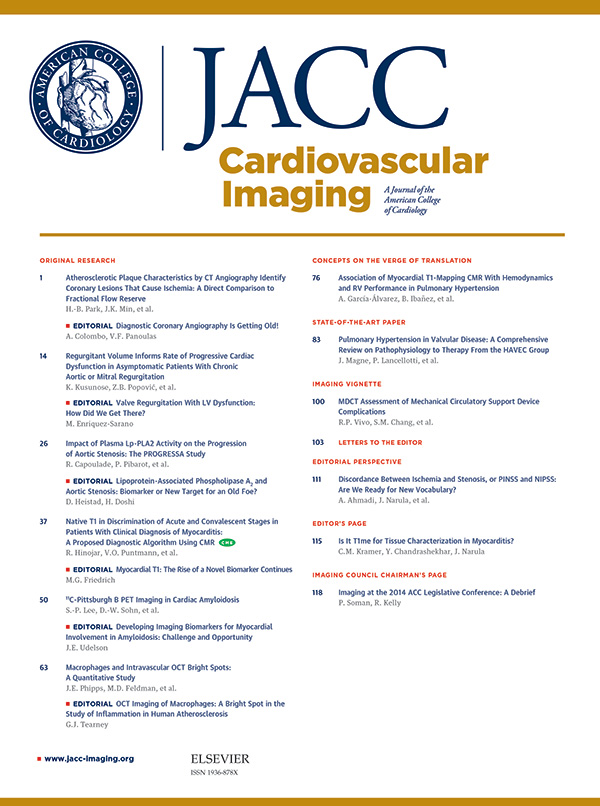
Among patients with seemingly first myocardial infarction (MI), 8.2 percent were found to have previously experienced a silent MI, which was also shown to be associated with a three-fold risk of mortality and major adverse cardiovascular event (MACE), according to research published in JACC: Cardiovascular Imaging.
Raquel P. Amier, MD, et al., performed a two-center observational longitudinal study including 392 patients presenting with first acute MI (AMI) between 2003 and 2013. Participants underwent late gadolinium enhancement cardiac magnetic resonance (LGE-CMR) examination within 14 days post-AMI.
Thirty-two patients (8.2 percent) showed silent MI. Left ventricular (LV) end-diastolic and end-systolic volumes did not differ significantly between patients with and without silent MI, but LV ejection fraction was significantly lower in those with silent MI (44±14 percent vs. 49±9 percent; p=0.006). Infarct size of AMI was comparable for patients with and without silent MI (median 23.8 g [interquartile range, 8.5-46.3 g] vs. 22.0 g [interquartile range, 10.5-34.1 g]; p=0.71). Infarct size of silent MI was 5.1 g (interquartile range, 1.4-11.5 g).
Occurrence of microvascular obstruction was similar between patients with and without silent MI (55 percent vs. 50 percent; p=0.71). Nine (28.1 percent) patients with silent MI died during follow-up, compared with 36 (10.0 percent) patients without silent MI. Twelve (41.4 percent) patients with silent MI experienced a MACE endpoint compared with 58 (17.7 percent) patients without silent MI.
Additionally, the authors found that the electrocardiogram has limited sensitivity for detection of silent MI and was not associated with long-term clinical outcome in this study.
"The prognostic value of silent MI may become useful in risk stratification to guide secondary prevention," the authors write. "Although silent MI is not a modifiable risk factor, the intensity of outpatient monitoring and pharmacologic cardioprotective treatment following AMI can be tailored to the individual patient."
Amier RP, Smulders MW, van der Flier WM, et al. JACC Cardiovasc Imaging 2018;11:1773-81.
Similar Readmission Rates in EVT, Thrombolysis in Acute Ischemic Stroke
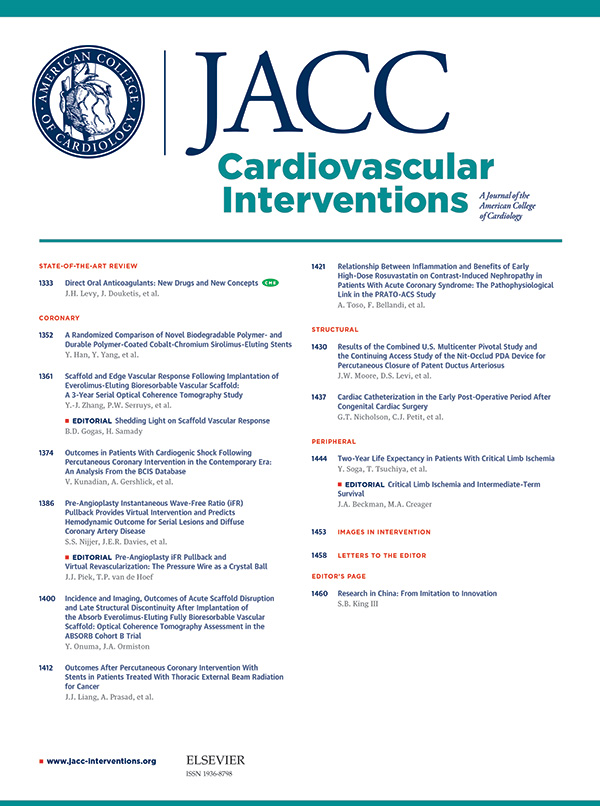
Thirty-day readmission were common in patients hospitalized with acute ischemic stroke who underwent endovascular thrombectomy (EVT), but were similar with those of patients treated with thrombolysis alone, according to a study published in JACC: Cardiovascular Interventions.
Using the Nationwide Readmissions Database, Islam Y. Elgendy, MD, et al., identified hospitalizations for a primary diagnosis of acute ischemic stroke during which patients underwent EVT, with or without intravenous thrombolysis.
Among 2,055,365 hospitalizations with acute ischemic stroke with survival to discharge, 70,046 (3.4 percent) received any recanalization therapy (i.e., EVT and/or thrombolysis). Of these, 10,795 (0.5 percent) underwent EVT with or without thrombolysis. Among the EVT patients, 1,304 (12.4 percent) were readmitted after 30 days with a median time for readmission of nine days (interquartile range, four to 18 days) after discharge.
Patient-centered characteristics identified as independent predictors of 30-day readmission include Medicare or Medicaid payer, diabetes, coagulopathy, gastrostomy tube placement, acute myocardial infarction, atrial fibrillation and heart failure during the index hospitalization. Thrombolysis coadministration with EVT was not an independent predictor of 30-day readmission.
Compared with thrombolysis alone, EVT had similar odds of 30-day readmissions (12.4 percent vs. 12.6 percent). Among the group who were treated with thrombolysis, those who received EVT had a higher rate of 30-day readmissions compared with those treated with thrombolysis alone (12.6 percent vs. 11.0 percent; p<0.01).
The most frequent reasons for readmission in those who underwent EVT were infections (17.2 percent), cardiac conditions (17.0 percent) and recurrent stroke/TIA (14.8 percent). Recurrent stroke/TIA (23.4 percent) was the most common reason for 30-day readmissions in those receiving thrombolysis alone. The authors conclude these findings emphasize the need for further optimization of secondary preventive measures and incorporation of comprehensive multidisciplinary treatment during presentation and transitions in care for acute ischemic stroke.
Elgendy IY, Omer MA, Kennedy KF, et al. JACC Cardiovasc Interv 2018;11:2414-24.
Clinical Topics: Acute Coronary Syndromes, Arrhythmias and Clinical EP, Cardiac Surgery, Cardiovascular Care Team, Dyslipidemia, Heart Failure and Cardiomyopathies, Invasive Cardiovascular Angiography and Intervention, Noninvasive Imaging, Prevention, Atherosclerotic Disease (CAD/PAD), SCD/Ventricular Arrhythmias, Atrial Fibrillation/Supraventricular Arrhythmias, Aortic Surgery, Cardiac Surgery and Arrhythmias, Cardiac Surgery and Heart Failure, Lipid Metabolism, Nonstatins, Novel Agents, Statins, Acute Heart Failure, Interventions and ACS, Interventions and Imaging, Interventions and Structural Heart Disease, Interventions and Vascular Medicine, Angiography, Echocardiography/Ultrasound, Nuclear Imaging
Keywords: ACC Publications, Cardiology Magazine, Acute Coronary Syndrome, Angina, Unstable, Angiography, Area Under Curve, American Heart Association, Arteries, Brain Ischemia, Cardiomyopathy, Hypertrophic, Atrial Fibrillation, Atherectomy, Echocardiography, Follow-Up Studies, Expert Testimony, Death, Sudden, Cardiac, Constriction, Pathologic, Gadolinium, Electrocardiography, Heart Failure, Hydroxymethylglutaryl-CoA Reductase Inhibitors, Gastrostomy, Lipids, Consensus, Magnetic Resonance Spectroscopy, Intermittent Claudication, Lower Extremity, Medicare, Longitudinal Studies, Myocardial Infarction, Diabetes Mellitus, Patient Readmission, Monitoring, Ambulatory, Percutaneous Coronary Intervention, Prognosis, Peripheral Arterial Disease, Radiology, Interventional, Risk Assessment, Odds Ratio, Random Allocation, Renal Artery Obstruction, Stents, Stroke, Stroke Volume, Survival Analysis, Risk Factors, Secondary Prevention, Medicaid, Syncope, Thrombectomy
< Back to Listings

